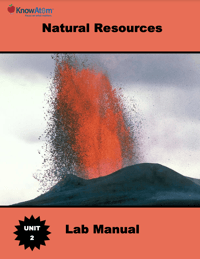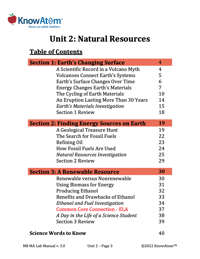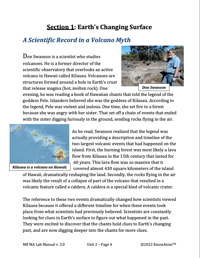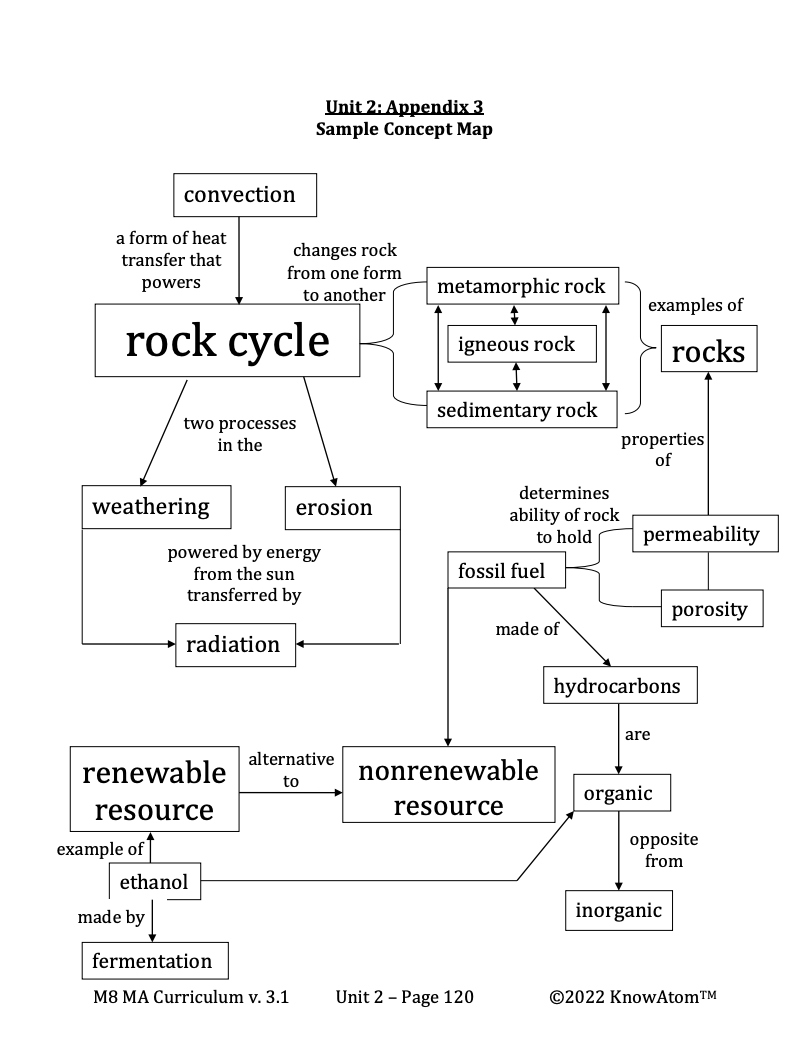Science background gives teachers more in-depth information on the phenomena students explore in this unit. Below is an excerpt from the science background section on the rock cycle.
Relationship Between Energy and Matter on Earth
Understanding Earth begins with the materials that make up Earth. Geologists need to have a good understanding of the relationship between energy and matter, and how energy changes matter, because none of the changes that take place on Earth’s surface can occur without energy.
Rocks are some of the most common materials on Earth. Most of the Earth’s ocean’s floors are made up of a dark, finely grained rock called basalt. Most of the continents are made up of granite, a coarse rock that often looks pink with black specks.
Both granite and basalt have something in common. Like all rocks, they are made up of mixtures of minerals that have been pressed together by heat and pressure. A mineral is a naturally occurring, inorganic solid with a crystal structure and its own chemical formula. Minerals are made of different elements that join together. Both granite and basalt have large amounts of the elements silicon and oxygen.
The matter that makes up rocks is never created or destroyed. Instead, it is constantly changed by processes that happen on Earth’s surface and deep within Earth’s interior. Heat, pressure, and time reshape and re-form one kind of rock into different kinds. The processes that form, break down, and re-form rock from one category to another are called the rock cycle.
Energy from Earth’s Interior
Some of the energy that shapes Earth’s surface comes from deep within Earth’s interior. Earth is divided into four layers. The inner core is Earth’s hottest layer, and it is made up of a mixture of solid iron and nickel. It is surrounded by an outer core that is made up of a less dense mixture of liquid nickel and iron.
Surrounding the inner and outer core is the mantle, which is mostly molten, semi-solid rock called magma. The mantle makes up almost two thirds of the Earth's volume and is about 2,900 km (1,802 miles) thick. The mantle is in constant motion, powered by the transfer of energy between materials.
Remember that heat is energy that has transferred whenever two substances are at different temperatures, and it always flows from faster-moving atoms (warmer substances) to slower-moving atoms (cooler substances) until both substances reach the same temperature.
Because of Earth’s structure, heat is continuously flowing from Earth’s center outward. Heat from Earth’s core warms the lower part of the mantle through conduction (heat transfer that occurs when molecules collide). When rocks near the core are heated, their particles move faster.
Earth Cross-Section
As the particles move faster, they become more spread out and less dense than the cooler, upper mantle rocks, whose particles are much slower. The cooler particles clump together, becoming denser. The warmer rocks rise while the cooler rocks sink, creating slow currents within the mantle. This tumbling motion describes a form of heat transfer called convection, which occurs in fluids (liquids and gasses).
The motion of convection in Earth’s mantle plays a major role in shaping Earth’s surface because Earth’s surface is fragmented into drifting slabs of solid rock, called tectonic plates. As magma moves beneath the crust (Earth’s crust is the hard rock layer of the planet that supports the continents and oceans), it pushes the tectonic plates toward or away from each other. The places where Earth’s tectonic plates meet are called fault lines.
Convection Powers Tectonic Plates
The tectonic plates are made up of Earth’s outermost 100 kilometers, made up of the crust and the coolest, strongest part of the upper mantle. This is called the lithosphere. The lithosphere floats on a zone of weak, melted rock called the asthenosphere.
The plates move extremely slowly, no more than a few centimeters a year, although the different plates move at varying speeds and in different directions. Scientists continue to study the complex behaviors of the plates.
Scientists know that as plates come into contact with each other, they transfer tremendous amounts of energy that cause various geological processes to happen at their boundaries. Their movements cause mountains, valleys, and oceans to form. These collisions between the plates are also the cause of earthquakes and volcanoes. Earthquakes are the shaking of the ground caused by a sudden release of energy when two tectonic plates suddenly slip past one another. Volcanoes are structures formed around a hole in Earth’s crust that release magma. When magma reaches the surface during an eruption, it is called lava.
Because of how they are formed, earthquakes and volcanoes are not found randomly across Earth’s surface. Instead, most are found along plate boundaries: on the edges of continents, near island chains, or underneath the ocean.
Creating New Land
The movement of the tectonic plates causes materials from deep within Earth’s interior to erupt onto Earth’s surface through volcanoes. When an eruption causes hot molten magma from deep within Earth’s interior to reach the surface, it cools, forming a category of rock called igneous rock. The word igneous means “from fire.” Basalt and granite are both forms of igneous rock.
As the lava cools, different-sized crystals are formed at different temperatures. This means the atoms are neatly organized to form a repeating pattern. This process is called crystallization, and it can occur rapidly or slowly.
When magma spews from a volcano, it cools very quickly when it is exposed to the cooler temperature of Earth’s oceans or atmosphere. This produces small crystals. Igneous rocks formed this way are fine-grained or glassy, such as basalt and obsidian.
In contrast, some magma is pushed slowly toward Earth’s surface over many years. This magma will cool, but at a much slower rate than magma erupting from a volcano. This produces much larger crystals, which results in coarser rock, such as granite.
As volcanoes spew lava onto the surface, where it cools into igneous rock, it produces new land on Earth’s surface. Because of this, the ongoing eruption on Kilauea has added 500 acres of new land since it first started in 1983. Because of this process, this is now some of the newest land on Earth. Like all matter, it came from already-existing Earth materials, and through various Earth processes, it was transformed into new land.
The Cycling of Earth Materials
There are other ways that geoscience processes cause Earth materials to change. For example, when two tectonic plates collide with one another, one plate sometimes is pushed beneath the other plate, back into the mantle. As far as 200 kilometers below the Earth’s surface, temperatures are hot enough to melt most rocks. It takes temperatures between 600 and 1,300 degrees Celsius (1,100 and 2,400 degrees Fahrenheit) to melt rock. Because of the extreme temperatures, much of the rock from the tectonic plate melts, forming magma.
At these temperatures, rock can also become deformed without melting. For example, when tectonic plates collide, they compress the materials making up Earth’s crust. The result is that the crust becomes shorter and thicker, building mountain ranges. When two tectonic plates move away from each other, they stretch the crust, causing it to become thinner. Deformation is a very slow process, taking millions of years.
Another category of rock is formed as a result of the tremendous heat and pressure of Earth’s interior. Metamorphic rocks are rocks formed in chemical reactions where one type of rock is changed by pressure or heat into a new type of rock with different properties. For example, the heat of Earth’s magma and the pressure of the rock layers above turn soft limestone into hard marble.
If rock gets buried deep inside Earth, heat and pressure will deform it, changing its external structure. Or the heat and pressure will cause chemical reactions that change the chemical structure of the rock, changing its properties.
Weathering and Erosion
When rocks on Earth’s surface are exposed to changes in temperature, wind, water or biological forces (such as plants or animals), they experience weathering.
Weathering is the result of interactions among all of Earth’s systems. For example, one of the gasses in the atmosphere is carbon dioxide. When water falls to Earth’s surface as rain, it carries some of this carbon dioxide, making the water slightly acidic. This slightly acidic water causes chemical weathering of the rocks on Earth’s surface. Chemical weathering occurs when chemical reactions break down the bonds holding the rocks together, causing them to fall apart, forming smaller and smaller pieces.
This is an interaction between the hydrosphere and the geosphere. The chemical weathering breaks down the rocks, transforming the matter into new substances with different properties, including salt and other minerals. Chemical weathering generally occurs gradually over time. Rocks are penetrable enough for water to seep into the cracks between particles. During cold months, the water turns to ice and expands, putting force on the rock. This is an interaction between the geosphere and the hydrosphere.
Rocks are also weathered by plants and animals. Plant roots that grow into the cracks between rocks weaken the structure. Earthworms and other burrowing creatures have a similar effect, spreading out rock particles and allowing water to reach deeper into the soil.
The Rock Cycle
As rock is weathered, it is broken down into sediment. That sediment is then transported by wind, water, and gravity to new locations, a process called erosion. The friction of erosion hastens weathering. Rocks grind against one another as the wind blows small bits of sediment against whole rock surfaces. Moving water currents wear down sharp cliff edges and drag loose rock to new locations along riverbeds. Sediment formed from weathering and erosion slowly accumulates in layers in oceans, lakes, and valleys through a process called sedimentation.
Heat and pressure compact the layers of sand, soil, clay, gravel, and other sediment that build up in one location over time into sedimentary rock. The layers represent a specific period of time. The oldest sediment forms the bottommost layers of the rock, while the new layers form at the top.
The processes that drive the rock cycle happen all the time and interchangeably. Wind and water can break sedimentary rock into smaller pieces of sediment that become new sedimentary rock. Igneous rock is the newest rock, formed from molten magma deep inside earth or cooling lava. Sedimentary rock can sink into Earth’s interior, where heat and pressure will turn it into metamorphic rock. Energy is the primary driver behind the rock cycle, breaking down and reforming rocks through heat and force.








